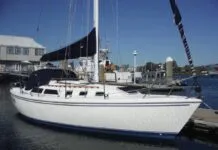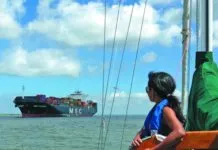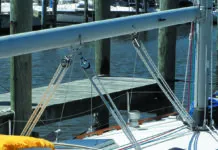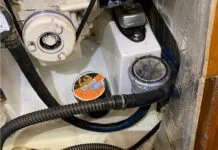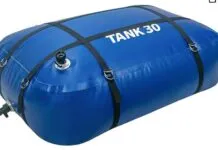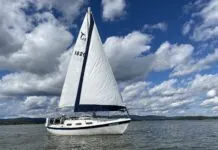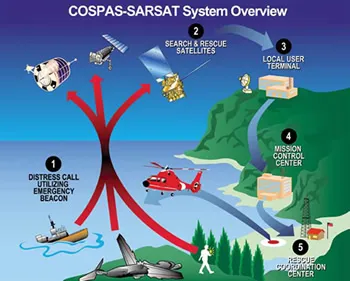
Illustration courtesy of NOAA
350
Sometime around 1:30 a.m. on April 28, while participating in the Newport-to-Ensenada race between Newport, Calif., and Ensenada, Mexico, the Hunter 376 Aegean sailed directly into the rocky cliffs of North Coronado Island off Mexico’s Pacific coast with four crew aboard. Later that morning, in daylight, fellow racers came upon pieces of the boat. The U.S. Coast Guard was notified. The boat, as one person later described, “looked like it had gone through a blender,” and many suspected a collision with a ship. The bodies of three crew—Bill Johnson, 57, of Torrance, Calif.; Joe Stewart, 64, of Bradenton, Fla.; and Kevin Rudolph, 53, of Manhattan Beach, Calif.—were soon discovered with the wreckage. The fourth body, that of the boat’s registered skipper, 49-year-old Capt. Theo Mavromatis, was found 16 days later.
Investigators are still trying to determine why a boat equipped with modern navigational equipment, including radar, and sailed by an experienced crew, would run into a well-charted island. One thing is clear. Contrary to news reports stating there “was no sign of distress” aboard Aegean, an SOS distress call went out from one of the crew—but by the time the Coast Guard learned of it, it was too late.
Mavromatis owned a SPOT Connect, a portable satellite messenger with an integral GPS receiver and a clearly labeled SOS button. If the device works as designed, when the SOS button is pressed, it delivers vital information—including the device’s GPS position, the identity of the owner, and emergency contact information—via Globalstar satellites to GEOS Alliance, a Texas-based company that monitors distress calls from the SPOT Connect and similar devices. GEOS then passes on the SOS alert and essential information to the U.S. Coast Guard (or whatever agency has jurisdiction over search and rescue in the area), which then takes charge of efforts to render assistance. In the case of Aegean, GEOS’s International Emergency Response Coordination Center (IERCC) received the SOS distress alert from Mavromatis’ SPOT Connect, but for reasons not yet fully understood, it received no GPS position. What occurred after that offers a revealing look at how devices such as the SPOT Connect—called Satellite Emergency Notification Devices, or SENDs—are, for better or worse, reshaping the world of search and rescue without any clearly defined blueprint.

220
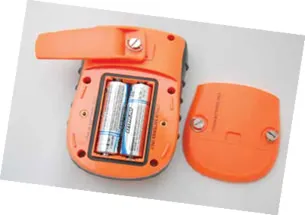
305
Voilá the ‘SEND’
The acronym “SEND” is a new one, officially assigned by the Radio Technical Commission for Maritime Services (RTCM) last year in its new SC-128 standard, which covers compact portable satellite messengers such as the SPOT Connect, the new DeLorme inReach, the BriarTek Cerberus, and others that enable users to notify third parties of an emergency via satellite. The third party can be your brother Bob in Seattle, or it can be an “alerting post,” such as the GEOS call center. These posts are also referred to as commercial emergency call centers, or CECCs.
The device that prompted the new SEND designation and RTCM standard, the original SPOT Messenger, arrived on the scene in 2008. PS tested it and gave it a tentative thumbs-up as a tracking device and backup for safety purposes. Our testers, however, questioned its advertised usefulness in a true distress situation. The unit was not as rugged as a 406 MHz EPIRB, a distress beacon required for ocean-going commercial vessels, or a Personal Locator Beacon (PLB), a smaller pocket-sized distress beacon that also operates on the 406 MHz frequency. Both PLBs and EPIRBs are closely regulated devices monitored by international search-and-rescue satellites (COSPAS-SARSAT). Our other concern at that time was that the emergency response center set up by GEOS to process SPOT distress alerts had virtually no prior experience with recreational marine distress calls.
Since then, the SPOT Messenger and GEOS call center have gone through some growing pains. Of the five variations of the SPOT that have been introduced, two have been the subjects of voluntary recalls. But the SPOT Messenger has also proven helpful in dozens of life-threatening situations on the water, including a few cases in which “official” distress alerting beacons like a 406 EPIRB or PLB were also onboard and either did not activate or the SPOT response proved faster. The GEOS response center also sharpened its performance. According to GEOS, the center participated in 262 maritime distress calls between July 2009 and June 15, 2012.
“In over 6,000 calls and over 2,000 initiated rescues, in over 100 countries, we have never been found negligent or at fault,” Mark Garver, CEO of GEOS Response, responded in an email to PS. “We follow IAMSAR (International Aeronautical and Maritime Search and Rescue) procedures as an alerting post, work closely with the National Search and Rescue Committee, Radio Technical Commission for Maritime Services, and the rescue coordination centers. Our two most senior staff members are former USCG SAR personnel, and our staff consists of trained first responders.”
The success of the SPOT Messenger prompted a wave of more powerful SEND devices such as the inReach and Cerberus. These devices employ Iridium’s 9602 modem, which allows for two-way communication; the SPOT’s big drawback is that it is only a one-way device. The new two-way SENDs permit the third party to reply to the person in distress, and, when paired with an Apple or Android smart mobile device, the new SENDs allow two-way communication by text or email. Some of these devices’ subscription plans include the GEOS emergency monitoring services in their subscription fees, and the others typically offer it as an option.
Effectively, GEOS has no competition and has become the default clearing house for SOS calls using SEND devices (and some satphones), as well as calls from drivers using the OnStar in-vehicle security system. According to Garver, the company now monitors more than a half-million of these devices worldwide, and that number is growing fast. (NOAA’s database for EPIRBs and PLBs, by comparison, has 329,000 registrations.) That means there are now more than half a million SOS buttons in the hands of people who have wide opinions of what constitutes an emergency. (In one widely publicized incident, helicopter rescue crews were dispatched three times to assist the same group of ill-prepared hikers in the Grand Canyon.)
Garver said the proportion of false alerts and hoaxes is growing smaller. “False alarm rates have averaged about 400 per year, however, a large percentage of these are caught by the IERCC immediately,” he said. “The fact that false alarms are down compared to number of devices would imply that users are now more aware of when to use them.”
It is expected that new two-way SEND devices will push the false alarm ratio down even further—but whether that will mean a reduction in the total number of non-distress calls is yet to be seen.
According to Patrick Shay, vice president and general manager of DeLorme, “They [members of the search and rescue community] have told us that we are solving one of the most vexing problems when responding to emergency calls—the inability to communicate with the sender to determine if it is a true emergency.”
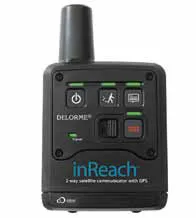
196

142
SEND Genesis
Presently, the SEND standard exists on paper only; none of the devices fully comply, and the standard deals almost exclusively with the device itself. Although SEND devices don’t operate on official maritime frequencies, the RTCM—an advisory board that sets standards for maritime electronics and communications devices (including EPIRBs)—was asked to become involved. The RTCM already had a standard for PLBs, and since the devices were similar, it was thought that many of the same criteria for PLBs could be applied to SENDs. A key difference, however, is that PLBs link directly into the tightly controlled COSPAS-SARSAT monitoring and response network, while SENDs rely on private call centers such as those operated by GEOS.
Joe Landa, CEO of Cerberus-maker BriarTek, believes it is a mistake to designate and promote these devices as maritime “emergency” devices, particularly since there are no firmly established guidelines for emergency call centers. His company promotes the Cerberus as a “communication” device. He also takes issue with the SEND standards process.
“If the search-and-rescue agencies need another emergency device, they should decide what they need, and invite companies to make it,” Landa said. “A search-and-rescue device shouldn’t originate from the manufacturers or service providers and then be fitted with a standard.”
By 2009, the SPOT Messenger was firmly established as a “safety” device. Rescues in remote places were widely publicized, and the SPOT garnered awards from dozens of outdoor and boating magazines that featured its ads. Most importantly, it began saving people’s lives.
“The primary issue as the IERCC sees it is not whether SEND devices are relevant, because they have saved a lot of lives,” Garver said. “The real issue is education of the users, education about putting relevant data into their profile, keeping the information up to date, and when to use the device.”
Without a standard for how the device should be built, operate, or how third parties should handle distress calls, however, the SAR community found itself having to deal with the proliferation of new devices.
“We’ve had to make adjustments, and we will continue to make adjustments,” said U.S. Coast Guard Cmdr. Mark Turner, who heads a committee helping to develop the protocols for commercial call centers. “One issue is that we have a different approach from that of the commercial call centers. They are businesses that work for the consumer. The Coast Guard is not interested in profits. We’re focused on saving lives.”
In the case of Aegean, even if the Coast Guard had been contacted immediately, it is not clear whether any response would have been swift enough to make a difference. Results from investigations by the U.S. Coast Guard and U.S. Sailing, the governing body for sailing in the U.S., are expected soon. (U.S. Sailing released a preliminary report in May confirming that Aegean hit North Coronado Island.)
A few details are clear. Winds at the time of the accident were relatively light, although a swell was running. The boat was likely making way under engine power at the time of the accident. Aegean did not have a 406 EPIRB, although 406 MHz EPIRBs are commonly rented for offshore races through the BoatUS Foundation.
The SPOT Connect did not enable the crew of Aegean to “live to tell about it,” as one of the early SPOT slogans touted, but it provided vital information to investigators trying to determine how the fatal accident occurred.
“Without the SPOT Connect, we might still be speculating about a collision,” said Chuck Hawley, chairman of U.S. Sailing’s Safety at Sea Committee and vice president of product development for marine retailer West Marine.
The SOS Button
Introduced in early 2011, the SPOT Connect is about the size of a cigarette pack. It costs $170 (the SPOT Messenger is down to $99), plus $99 per year for a basic service plan. Users must agree to a host of disclaimers relieving the maker and service providers of all liability.
The Connect can be operated as a stand-alone unit or can link wirelessly to the registered user’s iPhone or Android smart phone using Bluetooth technology. To make a distress call using the SPOT Connect, the user must swipe-switch the red SOS button on his phone’s touchscreen, or press the SOS button on the SPOT Connect device itself. Unlike the 406 EPIRBs and PLBs, it does not operate on frequencies dedicated for marine search-and-rescue purposes.
When the automated monitoring systems at GEOS (GEOS calls it Global Emergency Monitoring technology) received the distress alert from Mavromatis’ SPOT Connect, the system recognized that it did not have a GPS position.
SPOT brochures and website describe two response paths for distress signals: Upon receiving an SOS distress signal from a SPOT device, GEOS “notifies the appropriate emergency responders based on your GPS location and personal information.” In case the SPOT cannot acquire its location from the global positioning satellites, “it will still attempt to send a distress signal—without exact location—to GEOS, which will still notify your contacts of the signal and continue to monitor the network for further messages.”
Although his SPOT Connect’s distress signal gave no position data, Mavromatis’ device was programmed to post his position every 10 minutes on a semi-private website that showed his position so that his family could track him. The last tracked position of the SPOT Connect indicated it was virtually on the coast of North Coronado Island at about 1:30 a.m., approximately the same time the distress button was pushed. At that time, neither Mavromatis’ family nor GEOS was watching his progress. So although the position of the device was well documented, the distress signal was treated as if it had no position.
How could this happen?
GEOS monitors for SOS signals from SENDs; it does not constantly follow GPS tracks. Track data is treated as if it were a text message from the SPOT user to the people with whom he chooses to share his location. If GEOS receives an SOS distress with a GPS position, the response center also has access to button depression history or track data for the previous 12 hours.
When a distress signal has no GPS position—as occurred with the Aegean—obtaining past tracks requires a GEOS duty officer to contact the satellite network operator (Globalstar). At the time of the Aegean accident, however, duty officers were not directed to take this extra step, nor was Globalstar directed to automatically provide track data. Protocol required GEOS to call the emergency contact and continue to monitor the device.
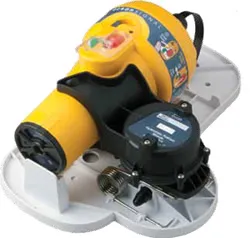
250
Shortly after the distress signal was received at 1:30 a.m., Mavromatis’ wife, Loren, received a phone call from GEOS’s rescue coordination center. She was asleep, so the report of the distress signal from her husband’s SPOT went to her voicemail. By the time she retrieved her voicemail and called race organizers asking about Aegean, it was well after sunrise, not long before fellow racers came across Aegean’s debris and contacted the Coast Guard.
Former PS contributor Doug Ritter, whose nonprofit Equipped to Survive Foundation (www.equipped.com) also tests SEND devices, explained how a SEND device could transmit a distress alert without a GPS position.
“Generally, at sea where the SEND has a clear view of the navigational satellites, getting a fix from GPS satellites is not a problem,” Ritter said. “But if waves wash over the unit, the unit is moving around violently, or a clear view of the sky is blocked by an obstruction, it might not get a fix. The distress signal, however, can still transmit in these situations where the horizon is obstructed—like a crevasse, for example—or even when the device is moving around too much to get a GPS position.” No emergency beacon works under water. Unlike 406 MHz EPIRBs, SENDs are not designed to float in transmit position.
Ritter is also the sole consumer advocate on the RTCM subcommittee that was set up to establish the SC-128 standards for the new SENDs.
The New Send Standard
RTCM committees and subcommittees are often made up of odd bedfellows. The SC-128 committee includes representatives from competing manufacturers such as ACR Electronics (a leading maker of EPIRBs and PLBs), BriarTek, and DeLorme, and satellite service providers such as Globalstar, Inmarsat and Irridium, along with representatives from various government agencies such as the National Oceanic and Atmospheric Administration (NOAA) and the Coast Guard.
The new standard for SEND devices was approved in May 2011. It still needs approval from the Federal Communications Commission, and because it gives very limited guidance about how to respond to SEND devices, GEOS is effectively breaking new ground in creating a response protocol.
“The RTCM Working Group does not set the standards for monitoring of these devices, however, the IERCC has been asked to provide our protocols as consideration for such standards since we are the pioneers in monitoring these devices,” Garver explained.
Ritter said the RTCM looks forward to reviewing the IERCC protocols. “To the best of my knowledge, while they have agreed in principle to cooperate, we have not been given anything yet.”
Coast Guard Cmdr. Turner said private call centers are understandably careful about revealing details they consider proprietary, including things such as performance reports, the ratio of false alerts, or subscriber databases.
“There are some things they probably don’t want to publicize or share,” Turner said.
One advantage of privatizing emergency call centers, Turner said, is that because subscription-based services like the SPOT must bill the user, they are motivated to keep credit-card databases current.
Ritter is less confident that a subscription database is infallible. “It’s a database like any other. And what happens if your subscription gets lost?”
It is a good question. In the U.S., NOAA maintains the registration database for 406 MHz devices. There is no subscription fee to register. Currently, only about
80 percent of 406 MHz devices (including EPIRBs and PLBs) in use are registered. More than 90 percent of all EPIRB alerts are false alerts, but about 65 percent of those are confirmed by calling the listed emergency contact or by using other information associated with the device in the NOAA database. Whether you are registered or not, SAR agencies will respond to a distress alert from a 406 MHz device as if it is an emergency.
It is not clear what will happen to your SEND distress call if you haven’t paid your bill or your account information is lost.
Globalstar attempts to notify its customers if their subscription has lapsed, but a spokesman emphasized that customers should not rely upon their SPOT device if their subscription has lapsed.
Garver, however, believes that GEOS has received distress calls from lapsed accounts. “We have responded to distress alerts where the owner has told us: ‘I let the subscription expire because I wasn’t using the device,’ ” he said.
406 MHz Devices vs. SENDs
The RTCM applies similar physical requirements—battery life, environmental testing, etc.—to SENDs as it did for compact 406 MHz PLBs. SENDs, however, can have re-chargeable and removable batteries, a vulnerability that opens the door for user error, battery failure, or water intrusion. PLBs use expensive long-life lithium batteries designed for at least five years of service.
The 406 MHz EPIRBs must function down to -40 degrees Celsius. The SEND standard, like that for PLBs, also allows for Class 2 devices, which are tested only down to -20 degrees Celsius. There are also two categories of SENDs: Category 1 devices float; Category 2 devices sink. The inReach floats. Cerberus and SPOT Connect sink. At present, no SEND device fully complies with SC-128, and it is unlikely that any Class 1 SENDs will appear on the market soon.
Under SC-128, a SEND device should provide valid position data within 10 minutes of activation “under good navigation conditions (i.e. with a clear view of the sky over the entire horizon above 30 degrees elevation angle).” This is the same standard required of GPS-equipped 406 MHz PLBs. If the Aegean was on the rocks of North Coronado, even a GPS-equipped PLB or EPIRB might be delayed in providing a timely position data because of the obscured horizon. If the EPIRB lacks an internal GPS, it can take up to 90 minutes for a 406 MHz device to give rescuers a position. Virtually all new 406 MHz EPIRBs today have internal GPS chips, ensuring a distress signal with a GPS fix is sent within about 10 minutes.
While PLBs and EPIRBs must pass a demanding test of electrical and transmission tests to get COSPAS-SARSAT approval, SENDs don’t undergo the same level of scrutiny. “There are a set of transmission tests in the SEND standard designed to try and ensure the device will work as intended in an emergency, but I don’t think anybody has tested a SEND device to these test requirements yet,” explained Chris Hoffman, who is the business development director at ACR Electronics and the chairman of the RTCM committee.
The COSPAS-SARSAT satellites, ground stations, and linked rescue coordination centers (RCCs) have been monitoring and responding to satellite distress signals for more than 25 years. In 2011, the COSPAS-SARSAT satellites were credited with saving 207 lives, 122 on the water, 14 from aviation incidents, and 71 in land situations when they used PLBs. Over the past three decades, COSPAS-SARSAT has evolved into a robust, highly automated network that is relatively transparent to the public and subject to strict standards and testing. It has also had some highly publicized failures.
When Mike Plant, the winner of the 1986-87 BOC Challenge was lost in the Atlantic in 1992, it was later discovered that Canadian and U.S. tracking stations had received a distress signal from his unregistered 406 MHz EPIRB, was not acted upon until it was far too late. The distress signal from the duly registered 406 MHz EPIRB from Rick and Paula Porter, a California cruising couple lost at sea in the Indian Ocean in 2002 went ignored for 10 days. In the April 2010 issue, we reported on a NOAA database snafu that resulted in a distress alert from a 406 MHz EPIRB registered to the owner of the 44-foot Beneteau Sean Seamour being ignored.
Once a rescue operation is launched, however, EPIRBs have a special advantage on the water: a homing signal. The 121.5 MHz homing signal that PLBs and EPIRBs currently emit is useful within about five miles, and the U.S. Coast Guard is close to operation with technology that will allow tracking of 406 MHz beacons at more than 100 miles away. SEND devices do not operate on frequencies that the U.S. Coast Guard uses for homing.
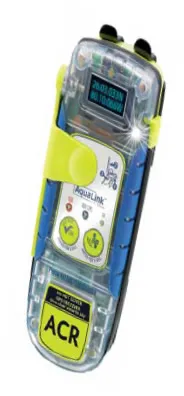
184
Tracking Aegean
As a result of the Aegean incident, GEOS has changed its protocol for responding to alerts with no position data. Now, when a distress alert is received without position data, the response protocol includes a search for any track data.
“We did this previously via technology and are now adding that the duty officer will call the satellite provider’s control/operations center to verify whether there are tracks available,” Garver wrote, in a 10-page document describing in detail GEOS operations for Practical Sailor.
Ritter, of Equipped to Survive, explained that because PLBs and EPIRBs are not tracked prior to the distress call, the Aegean incident presented a situation that fell outside the usual SAR scenario. “I don’t think anyone on the (SC-128) committee talked very much about how to handle tracking data,” he said. “It wasn’t a situation that came up.”
SENDs present a double-edged sword for companies such as GEOS. Overreact to every red button, and the company’s good relationship with SAR officials is put in jeopardy. Delay a response, and people could die.
“We aren’t responsible if we communicate a false distress signal to the authorities,” said Garver. “We do, however, make every effort to ensure the distress signal is valid. It can definitely impact the responding agencies confidence, if we were to send them a number of false alerts.”
Turner described the way the Coast Guard handles distress alerts differently. “We operate on the assumption that every distress alert is valid, begin mobilizing assets and simultaneously work to confirm the distress and gather more information. The process continues until the false alert is cancelled.”
The inter-agency National Search-and-Rescue Committee (NSAR) has formed a working group to help develop protocols for commercial call centers, but it focuses on fundamentals—how to correctly state latitude and longitude, etc. It doesn’t get into how tracking data should be handled or what sort of front-end sleuth work commercial call centers should be engaged in when position data or other key information is missing. According to Turner, it is not even clear which agency should be involved in regulating the call centers. In the meantime, GEOS forges ahead.
“With our experience of the early devices, we knew what we needed both in terms of information for response, we knew what users needed and how to even better reduce unintentional false alarms,” Garver said.
The Way Ahead
It seems clear that the way SEND devices are made, how they function, and how commercial call centers operate will evolve over time, and that private companies will be the primary drivers behind all of these factors.
Some SAR watchers, like Ritter, see subscription-based services as challenging the dominance of COSPAS-SARSAT 406 EPIRBs and PLBs in the larger marketplace for recreational sports, such as sailing.
“They have a strong appeal for the ordinary outdoors person,” Ritter said. “Why buy a device that only works in an emergency when they can buy a SEND device that offers all kinds of other features? But I still believe that if you are most concerned about distress signalling at sea, a 406 MHz EPIRB with internal GPS positioning is the way to go.”
Hawley, of West Marine, agrees. He sees a place for SEND units on many boats, but reiterates that a 406 MHz EPIRB should be a first choice for those engaged in offshore sailing. He also points out that any distress communication device requires that boaters be educated on their proper use.
“Even the best tools have to be used correctly,” Hawley said. “There are large numbers of unregistered SARSAT devices, large numbers of VHF/DSC radios with no Mobile Maritime Service Identity number or GPS attached, and large numbers of potentially useful devices with dead batteries. Our goal, as buyers and potential users of these devices, is to make sure that we give rescuers the best chance of finding us early and efficiently.”
Landa, of BriarTek, worries that SEND makers and vendors are placing too much emphasis on SENDs’ distress signalling capabilities. “We need to promote the things SENDs are good at. They are a great help in all kinds of situations where people need help—say you need a tow because you ran aground, or somebody is hurt but not so badly that he needs a helicopter evacuation—but they are not a substitute for 406 EPIRBs or PLBs. I’m afraid that as long as they are promoted that way, we are going to see more cases like the Aegean.”
Given the history of electronic distress signaling, it seems clear that whatever red button you push, there are no 100-percent guarantees. From our perspective, GPS-enabled 406 MHz EPIRBs remain our first choice for offshore sailors and 406 MHz PLBs stand next in line as backup. The new SENDs offer impressive features, but their maritime distress-signalling capabilities remain a work in progress.
Sc-128, the new standard for Satellite Emergency Notification Devices such as the SPOT Connect do not specify how emergency call centers should operate. Annex D in SC-108, lists only a few recommended minimum requirements for a SEND Emergency Call Center:
• 24/7/365 operation.
• Staff must be literate in at least the English language and languages or translation services relevant to the proposed geographical areas of operation.
• Backup facilities in case of power outages or disaster.
• Backed-up data files and software (held for at least 3 years).
• Access to a database providing geo-located contact details for the emergency services covering the geographical area of intended service provision.
• Communications with emergency services to be carried out in accordance with the standards.





